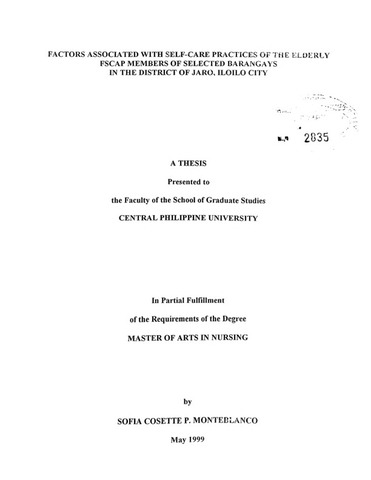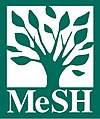Factors associated with self-care practices of the elderly FSCAP members of selected barangays in the district of Jaro, Iloilo City
Abstract
A growing consciousness especially of the elderly’s well-being and health needs has emerged in our country because of their increasing number. They now assume considerable amount of responsibility for their own health care. This is referred to as self-care where activities are performed by the aged on their own behalf in health promotion and prevention and in disease detection and treatment. It is in this light, that this study was conducted to determine self-care practices of the elderlies in five selected barangays in the district of Jaro, Iloilo City namely, Dungon A. Dungon B, San Isidro, San Roque and Ungka. The self-care practices included are some promotive, preventive and curative dimensions. This study aimed to determine the relationship between selected factors: age, gender, work status, income and educational attainment and selfcare practices. The respondents of the study were 252 elderlies who were registered members of their barangay’s Federation of Senior Citizens Association of the Philippines (FSCAP) at the time of the survey.
Specifically, this study aimed to ascertain the demographic characteristics of the elderlies in the target barangays in terms of age, gender, work status, income and educational attainment. Furthermore, it endeavored to ascertain the following: a) promotive self-care practices of the elderlies in terms of nutrition, exercise, avoidance of harmful habits and hygienic practices, b) preventive self-care practices of the elderlies in terms of health screening, utilization of health and health-related services and immunization, and c) curative self-care practices of the elderlies in terms of their medication-taking and treatment practices for specific health conditions.
Likewise, this study sought to find out whether: a) the elderlies' eating habits, nutrition, exercise, avoidance of harmful habits and hygienic practices are associated with age, gender, work status, income and educational attainment, b) health screening practices, utilization of health and health-related services and immunization practices of the elderlies are associated with age, gender, work status, income and educational attainment, and c) medication-taking practices and treatment practices of the elderlies are associated with age, gender, work status, income and educational attainment.
The results of the study showed that the majority of the elderlies were in their late 60’s (69.23 years old on the average), were elementary educated and unemployed at the time of the study. Those working were involved in vending and were earning an average monthly income of P 1,838.80. Most of the respondents were receiving financial assistance from family members, and many were also receiving goods (food, grocery, and medicine) from relatives and friends. Their average income from all sources both in cash and in kind, was P3,733.02.
To promote health, almost all of the respondents were eating three full meals a day. Seven in ten usually had snacks which consisted mainly of a beverage and a carbohydrate food (bread, biscuit or root crop). Based on their food intake, more than half of the elderlies, were taking “inadequate” food. The usual taste of food eaten by the respondents was insipid or lacking in taste. Nine in ten of the elderlies had “fair” eating habits.
Almost all of the respondents were engaged in routine exercise with more than one half performing aerobic exercises, like brisk walking, dancing, etc. They were spending 15 minutes to 1 hour per exercise session. A substantial portion of the elderlies however, were not observing regular exercise time.
Most of the elderlies were not engaged in harmful habits like smoking and drinking liquor. Comparatively, there were more men than women who were indulging in unhealthy habits. The majority of the elderlies had good hygienic practices since most of them were performing at least seven of ten health activities to maintain personal hygiene.
For prevention of illness, a large majority of the elderlies consulted with a private physician in a private clinic or in the out-patient department of a hospital for regular check-up.
A big majority of the respondents since they had “poor” immunization status had not received any immunization for the past twelve months.
Most of them had physical examination and laboratory diagnostics during the past year.
Almost all of the respondents had taken medication during their last illness and most of them assumed the responsibility of regulating their own medication. Majority of them also purchased their own medicines at the drugstore and stored their own medicines. The elderlies manifested a “good” knowledge about the drugs they were taking, the dosage and the frequency of taking. On the whole, most of the respondents had “fair” medication-taking practices.
The elderlies were also found to be suffering from one to two chronic ailments, the most common of which were dizziness, fever, knee and joint pains, headache, cough, dimness of vision and indigestion. A combination of rest, taking pharmaceutical drugs or herbal plants and water therapy were the most frequent treatment measures used by those who had become ill.
The findings of the study revealed that there was a significant relationship between; a) eating habits and work status, b) eating habits and educational attainment c) exercise and gender, d) avoidance of harmful habits and gender, e) hygienic practices an educational attainment f) health screening practices and income, g) health screening practices and education utilization of health and health-related services and work status., and h) medication-taking practices and educational attainment.
From the findings of the study, the following conclusions were drawn:
1. Elderlies who are not working tended to have better eating habits than those who are employed.
2. Male elderlies have better exercise practices than their female counterparts.
3. Male elderlies significantly differ from female elderlies in terms of avoidance of harmful habits with the women exhibiting better avoidance than the men.
4. Older elderlies did not tend to avoid harmful habits to a “higher” degree when compared to the younger ones.
5. Elderlies with higher education have better hygienic practices than those with lesser schooling.
6. Regardless of age, the elderlies utilized health and health-related services less frequently.
7. Irrespective of age and employment status, elderlies tended to have poor health screening practices and immunization practices.
8. The elderlies’ utilization of health and health related services is significantly influenced by their work status.
9. The elderlies’ educational attainment did not, in any way, influence their level of exercise and degree of avoidance of harmful habits.
10. Level of health screening practices, utilization of health and health-related services and immunization practices did not vary between the male and female elderlies.
11. As income increases, health screening practices improves. However irrespective of income, work status, and educational attainment, the elderlies tended to have poor immunization status.
12. College-educated elderlies have better health screening practices and medication taking practices than those with less education.
The following recommendations are forwarded based on the findings and conclusions:
1. It is envisioned that the following be made aware of the results of the study: The Department of Health and the Department of Social Welfare and Development, non-government organizations committed to assisting the elderlies, local government units, elderly care-givers and FSCAP.
2. Health education classes which maybe conducted at the health center should focus on selection of inexpensive food which have good value content, determination of nutritive value of food available in the market and demonstration in the preparation of simple and nutritious meals.
3. For exercises to be enjoyable and an activity that the elderly could look forward to, the local FSCAP may plan for regular aerobic sessions, or ballroom dancing or any exercise routine to target especially the women whose exercise practices were found to be inadequate.
4. Posters with relevant and eye-catching slogans cold be put-up in strategic locations like drugstores, public markets, churches and barangay halls.
5. Considering the poor health screening practices of the elderlies vis-a-vis the increasing cost of health care and their low income, functioning health services could be developed to the fullest extent possible in the community.
6. Barangay health centers and elderly clinics should provide health services to the employed elderlies even after the regular working hours.
7. In developing future policies for the elderlies, policy makers are encouraged / to take the following considerations: a) ways and means to maximize the independence of the elderlies and to enable them to remain with their families and their familiar environment for as long as possible, b) wide range of differences in the elderlies’ personal identities, their physical capabilities and income as well as their own perception of needs, c) a need to reassess existing health and social services, d) to strengthen the resources for the family to permit it to remain a primary care-giver to the elderly, substantial tax credits, free basic training in elderly care and free comprehensive health services are a few incentives that could support the family.
8. Support groups and non-government organizations committed in upholding the cause of the elderlies could be instrumental in assisting the FSCAP lobby to the Department of Health for budget allocations to help meet the articulated needs of the elderlies.
9. The sectoral representative of elderlies in Congress could rally for the passage of laws directed towards strengthening policies to improve health conditions in terms of preventive and developmental measures as well as remedial when required.
10. Education classes at the health centers and elderly clinics should stress the importance of the following: hygienic practices, needs for immunization to prevent infectious diseases, how to avail of immunization, misconception about immunization and how to regulate their own medication.
The following studies are further recommended:
1. A study to evaluate the effectiveness of programs for the elderly in terms of their positive effects on their lives.
2. A study that should look into other factors influencing self-care practices should be conducted. Among the variables worth studying are: the social and psychological dimensions of aging, rehabilitative self-care practices ((the fourth level of care not considered in my study), functional health status, health outcomes as valued by people across cultures, gender differences in these values, and health seeking behaviors.
3. A replication of the study to include as samples elderlies who are not FSCAP members and elderlies who reside in institutions or nursing homes.
Description
Abstract only
Associated Content
Full paper published in CPU Research JournalSuggested Citation
Monteblanco, S. C. P. (1999). Factors associated with self-care practices of the elderly FSCAP members of selected barangays in the district of Jaro, Iloilo City (Unpublished Master's thesis). Central Philippine University, Jaro, Iloilo City.
Type
ThesisSubject(s)
Keywords
Department
School of Graduate StudiesDegree
Master of Arts in NursingShelf Location
GSL Theses 610.73072 M764
Physical Description
xvii, 160 leaves
Collections
The following license files are associated with this item:





